"F-15" redirects here. For other uses, see F15 (disambiguation).
| F-15 Eagle | |
|---|---|
| USAF F-15C over Washington, D.C | |
| Role | Air superiority fighter |
| Manufacturer | McDonnell Douglas Boeing IDS |
| First flight | 27 July 1972 |
| Introduction | 9 January 1976 |
| Status | Active |
| Primary users | United States Air Force Japan Air Self-Defense Force Royal Saudi Air Force Israeli Air Force |
| Number built | F-15A/B/C/D/J/DJ: 1,198[1] |
| Unit cost | F-15A/B: US$27.9 million (1998) F-15C/D: US$29.9 million (1998)[2] |
| Variants | McDonnell Douglas F-15E Strike Eagle McDonnell Douglas F-15 STOL/MTD Boeing F-15SE Silent Eagle Mitsubishi F-15 |
Since the 1970s, the Eagle has also been exported to Israel, Japan, and Saudi Arabia. Despite originally being envisioned as a pure air superiority aircraft, the design proved flexible enough that an all-weather strike derivative, the F-15E Strike Eagle, was later developed, and entered service in 1989.
Contents
|
Development
Origins
Following studies in 1964–1965, the U.S. Air Force developed requirements for an air superiority fighter in October 1965. Then on 8 December 1965, the Air Force issued a request for proposals (RFP) for the new fighter. The request called for both air-to-air and air-to-ground capabilities. Eight companies responded with proposals. In the following study phase, four of these companies developed some 500 design concepts. Typical designs featured variable-sweep wings, weighed over 60,000 lb (27,200 kg), included a top speed of Mach 2.7 and a thrust-to-weight ratio of 0.75.[6] The designs were not accepted by the Air Force as they compromised fighter qualities for ground attack qualities.[7] Acceptance of the Energy-Maneuverability (E-M) theory by the Air Force led to a change in requirements for improved maneuverability by the spring 1967. The design mission weight was reduced to 40,000 lb (18,100 kg), top speed reduced to Mach 2.3-2.5 and thrust-to-weight ratio increased to 0.97.[6]In 1967 U.S. intelligence was surprised[8] to find that the Soviet Union was producing a large fighter aircraft, the MiG-25 'Foxbat'.[9] It was not known in the West at the time that the MiG-25 was designed as a high-speed interceptor, not an air superiority fighter,[10] so its primary asset was speed, not maneuverability. The MiG-25's huge tailplanes and vertical stabilizers (tail fins) hinted at a very maneuverable aircraft, which worried the Air Force that its performance might be better than its U.S. counterparts. In reality, the MiG's large fins and stabilators were necessary to prevent the aircraft from encountering inertia coupling in high-speed, high-altitude flight.
The F-4 Phantom II of the USAF and U.S. Navy was the only fighter with enough power, range, and maneuverability to be given the primary task of dealing with the threat of Soviet fighters while flying with visual engagement rules.[9] As a matter of policy, the Phantoms could not engage targets without positive visual identification, so they could not engage targets at long ranges, as designed. Medium-range AIM-7 Sparrow missiles, and to a lesser degree even the AIM-9 Sidewinder, were often unreliable and ineffective at close ranges where it was found that guns were often the only effective weapon.[11] The Phantom did not originally have a gun, but experience in Vietnam led to the addition of a gun. An external gun pod was tried and later the M61 Vulcan was integrated internally on the F-4E.
F-X program
There was a clear need for a new fighter that overcame the close-range limitation of the Phantom while retaining long-range air superiority. After rejecting the U.S. Navy VFX program (which led to the F-14 Tomcat) as being unsuited to its needs, the U.S. Air Force issued its own requirements for the Fighter Experimental (F-X), a specification for a relatively lightweight air superiority fighter.[12] The requirements called for single-seat fighter having a maximum take-off weight of 40,000 lb (18,100 kg) for the air-to-air role with a maximum speed of Mach 2.5 and a thrust to weight ratio of nearly 1 at mission weight.[13] Four companies submitted proposals, with the Air Force eliminating General Dynamics and awarded contracts to Fairchild Republic, North American Rockwell, and McDonnell Douglas for the definition phase in December 1968. The companies submitted technical proposals by June 1969. The Air Force announced the selection of McDonnell Douglas on 23 December 1969.[14] The winning design resembled the twin-tailed F-14, but with fixed wings. It would not be significantly lighter or smaller than the F-4 that it would replace.The Eagle's initial versions were the F-15A single-seat variant and F-15B twin-seat variant. The F-15B was originally designated TF-15A, but this was dropped, as it is fully combat-capable. These versions would be powered by new Pratt & Whitney F100 engines to achieve a combat thrust-to-weight ratio in excess of 1. A proposed 25 mm Ford-Philco GAU-7 cannon with caseless ammunition suffered development problems. It was dropped in favor of the standard M61 Vulcan gun. The F-15 used conformal carriage of four Sparrow missiles like the Phantom. The fixed wing was put onto a flat, wide fuselage that also provided an effective lifting surface. The first F-15A flight was made in July 1972 with the first flight of the two-seat F-15B following in July 1973.[15]
The F-15 has a "look-down/shoot-down" radar that can distinguish low-flying moving targets from ground clutter. The F-15 would use computer technology with new controls and displays to lower pilot workload and require only one pilot to save weight. Unlike the F-14 or F-4, the F-15 has only a single canopy frame with clear vision forward. The USAF introduced the F-15 as "the first dedicated USAF air superiority fighter since the F-86 Sabre."[16]
The F-15 was favored by customers such as the Israel Air Force and Japan Air Self-Defense Force. Criticism from the fighter mafia that the F-15 was too large to be a dedicated dogfighter, and too expensive to procure in large numbers, led to the Lightweight Fighter (LWF) program, which led to the USAF F-16 Fighting Falcon and the middle-weight Navy F/A-18 Hornet.[17]
Further development
The single-seat F-15C and two-seat F-15D models entered production in 1978 with the models' first flights in February and June of that year.[18] These new models have Production Eagle Package (PEP 2000) improvements, including 2,000 lb (900 kg) of additional internal fuel, provisions for carrying exterior conformal fuel tanks and increased maximum takeoff weight of up to 68,000 lb (30,700 kg).[19] The additional takeoff weight allows internal fuel, a full weapons load, conformal fuel tanks, and three external fuel tanks to be carried. The APG-63 radar uses a programmable signal processor (PSP), so that when there is a need to upgrade the radar in the future for more advanced weaponry developed later, only reprogramming is needed. The PSP was the first of its kind in the world, and the upgraded APG-63 radar was the first radar to use it. Other improvements on the C and D models included strengthened landing gear, radar improvements, and a new digital central computer.[20] An overload warning system was also added, which allows the pilot to fly the fighter to 9 g at all weights.[18]The F-15 Multistage Improvement Program (MSIP) was initiated in February 1983 with the first production MSIP F-15C produced in 1985. Improvements included an upgraded central computer; a Programmable Armament Control Set, allowing for advanced versions of the AIM-7, AIM-9, and AIM-120A missiles; and an expanded Tactical Electronic Warfare System that provides improvements to the ALR-56C radar warning receiver and ALQ-135 countermeasure set. The final 43 F-15Cs included the enhanced-capability Hughes APG-70 radar, which was developed for the F-15E. These 43 F-15Cs with APG-70 radar are sometimes referred as Enhanced Eagles. The earlier MSIP F-15Cs with the APG-63 were later upgraded to the APG-63(V)1, which significantly improved reliability and maintainability while providing performance similar to the APG-70. The improvements were retrofitted to existing F-15s.[21]
In 1979, McDonnell Douglas and F-15 radar manufacturer, Hughes, teamed to privately develop a strike version of the F-15. This version competed in the Air Force's Dual-Role Fighter competition starting in 1982. The F-15E strike variant was selected for production in 1984.[22]
Beginning in 1985, F-15C and D models were equipped with the improved P&W F100-220 engine. It added a digital engine control to allow for quicker throttle response, less wear, and reduced fuel consumption. The original F100-100 engines were upgraded to a similar configuration with the designation F100-200E starting in 1997 and were ongoing as of 2007.[23]
Recent upgrades include retrofiting 178 F-15C fighters with the AN/APG-63(V)3 Active Electronically Scanned Array (AESA) radar with delivery beginning in early 2009.[24] Additionally, the Air Force also plans to upgrade other F-15s with the Joint Helmet Mounted Cueing System (JHMCS).[25] Lockheed Martin is working on an IRST system for the F-15C.[26]
Design
The F-15 has an all-metal semi-monocoque fuselage with a large cantilever shoulder-mounted wing. The empennage is metal and composite construction, with twin aluminum/composite honeycomb fins with boron-composite skins, resulting in an exceptionally thin tailplane and rudders with all-moving composite horizontal tail surfaces outboard of the fins. The F-15 has a spine-mounted air brake and retractable tricycle landing gear. It is powered by two Pratt & Whitney F100 axial-flow turbofan engines with afterburners mounted side-by-side in the fuselage. The cockpit is mounted high in the forward fuselage with a one-piece windscreen and large canopy to increase visibility.The F-15's maneuverability is derived from low wing loading (weight to wing area ratio) with a high thrust-to-weight ratio enabling the aircraft to turn tightly without losing airspeed. The F-15 can climb to 30,000 ft (10,000 m) in around 60 seconds. The thrust output of the dual engines is greater than the aircraft's weight, thus giving it the ability to accelerate in a vertical climb. The weapons and flight control systems are designed so that one person can safely and effectively perform air-to-air combat.[12] The A and C-models are single-seat variants that make up the bulk of F-15 production. B and D-models add a second seat behind the pilot for training. E-models use the second seat for a bombardier/navigator. Visibly, the F-15 has a unique feature vis a vis other modern fighter aircraft in that it does not have the distinctive turkey feather aerodynamic exhaust petals covering its engine nozzles; this is because the design used on the F-15 was balky and problematic and tended to fall off in flight, resulting in a hazard for people on the ground; as a result they were removed. The F-15 suffers a 3% drag penalty without them.[27]
A multi-mission avionics system includes a heads-up display (HUD), advanced radar, inertial guidance system (INS), flight instruments, ultra high frequency (UHF) communications, and Tactical Air Navigation (TACAN) and Instrument Landing System (ILS) receivers. It also has an internally mounted, tactical electronic-warfare system, identification, friend or foe (IFF) system, electronic countermeasures suite and a central digital computer.[28]

A wing over maneuver displays the clean lines and high-wing design of an F-15E from Elmendorf AFB, AK.
The F-15's versatile APG-63/70 pulse-Doppler radar system can look up at high-flying targets and down at low-flying targets without being confused by ground clutter. It can detect and track aircraft and small high-speed targets at distances beyond visual range (the maximum being 120 nautical miles (220 km) away) down to close range, and at altitudes down to treetop level. The radar feeds target information into the central computer for effective weapons delivery. The capability of locking onto targets as far as 50 nautical miles (90 km) with an AIM-120 AMRAAM missile enables true beyond visual range (BVR) engagement of targets. For close-in dogfights, the radar automatically acquires enemy aircraft, and this information is projected on the heads-up display. The F-15's electronic warfare system provides both threat warning and automatic countermeasures against selected threats.[30]
A variety of air-to-air weaponry can be carried by the F-15. An automated weapon system enables the pilot to perform aerial combat safely and effectively, using the heads-up display and the avionics and weapons controls located on the engine throttles or control stick. When the pilot changes from one weapon system to another, visual guidance for the required weapon automatically appears on the heads-up display.[31]
The Eagle can be armed with combinations of four different air-to-air weapons: AIM-7F/M Sparrow missiles or AIM-120 AMRAAM advanced medium range air-to-air missiles on its lower fuselage corners, AIM-9L/M Sidewinder or AIM-120 missiles on two pylons under the wings, and an internal M61A1 20 mm Gatling gun in the right wing root.[32]
Low-drag conformal fuel tanks (CFTs) were developed for the F-15C and D models. They can be attached to the sides of the engine air intake trunks under each wing and are designed to the same load factors and airspeed limits as the basic aircraft.[32] They degrade performance by increasing drag and cannot be jettisoned in-flight (unlike conventional external tanks). Each conformal fuel tank can hold 750 U.S. gallons (2,840 L) of fuel.[33] These tanks increase range thus reducing the need for in-flight refueling. All external stations for munitions remain available with the tanks in use. Moreover, Sparrow or AMRAAM missiles can be attached to the corners of the conformal fuel tanks.[19] The 57 FIS based at Keflavik NAS, Iceland was the only C-model squadron to utilize CFTs on a regular basis due to its extended operations over the North Atlantic. With the closure of the 57 FIS the F-15E is the only U.S. variant to carry them on a routine basis. The American CFTs were also provided to Israel and Saudi Arabia but only Israel uses them (as needed) on their entire fleet.

M61 Vulcan mounted on the side of right engine intake.
The APG-63(V)2 Active Electronically Scanned Array (AESA) radar has been retrofitted to 18 U.S. Air Force F-15C aircraft.[35] This upgrade includes most of the new hardware from the APG-63(V)1, but adds an AESA to provide increased pilot situational awareness. The AESA radar has an exceptionally agile beam, providing nearly instantaneous track updates and enhanced multi-target tracking capability. The APG-63(V)2 is compatible with current F-15C weapon loads and enables pilots to take full advantage of AIM-120 AMRAAM capabilities, simultaneously guiding multiple missiles to several targets widely spaced in azimuth, elevation, or range.
Operational history
Introduction and early service
The largest operator of the F-15 is the United States Air Force. The first Eagle (F-15B) was delivered 14 November 1974.[36] In January 1976, the first Eagle destined for a combat squadron, the 555th TFS, was delivered.[36] These initial aircraft carried the Hughes Aircraft (now Raytheon) APG-63 radar.The first F-15 kill was scored by IAF ace Moshe Melnik in 1979.[37] In 1979–81, during Israeli raids against Palestinian factions based in Lebanon, F-15As downed 13 Syrian MiG-21 "Fishbeds" and two Syrian MiG-25 "Foxbats", the latter being the aircraft the F-15 was designed to kill. Israeli F-15As and Bs participated as escorts in Operation Opera and served during the 1982 Lebanon War. During the latter, Israeli F-15s shot down 40 Syrian jet fighters (23 MiG-21 "Fishbeds" and 17 MiG-23 "Floggers") and one Syrian SA.342L Gazelle helicopter.[38] According to some Soviet and Russian historians, three Israeli F-15s were shot down in either October 1982,[39][verification needed] December 1982,[40][verification needed] or October 1983[41][42][verification needed] by newly delivered Syrian MiG-23MLs. Later during 1985, IAF Eagles, in Operation Wooden Leg, bombed the PLO headquarters in Tunisia.[43] This was one of the few times air superiority F-15s (A/B/C/D models) were used in tactical strike missions.
Royal Saudi Air Force F-15C pilots shot down two F-4E Phantom IIs flown by the Iranian Air Force in a skirmish in June 1984, and shot down two Iraqi Mirage F1s during the Gulf War.[44][45][46]
Satellite killer
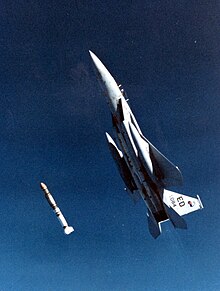
ASM-135 ASAT test launch from F-15A 76-0084
The third test flight involved a retired P78-1 solar observatory satellite in a 345-mile (555 km) orbit, which was successfully destroyed by kinetic energy.[50] The pilot, USAF Major Wilbert D. "Doug" Pearson, became the first and only pilot to destroy a satellite.[51][52] The ASAT program involved five test launches. The program was officially terminated in 1988.[49][51]
Gulf war and aftermath
The USAF deployed F-15C, D and E models to the Persian Gulf in 1991 in support of Operation Desert Storm where they accounted for 36 of the 39 Air Force air-to-air victories. F-15Es were operated mainly at night, hunting modified SCUD missile launchers and artillery sites using the LANTIRN system.[53] According to the USAF, its F-15Cs had 34 confirmed kills of Iraqi aircraft during the 1991 Gulf War, mostly by missile fire: five MiG-29 "Fulcrums", two MiG-25 "Foxbats", eight MiG-23 "Floggers", two MiG-21 "Fishbeds", two Su-25 "Frogfoots", four Su-22 "Fitters", one Su-7, six Mirage F1s, one Il-76 cargo plane, one Pilatus PC-9 trainer, and two Mi-8 helicopters. After air superiority was achieved in the first three days of the conflict, many of the later kills were reportedly of Iraqi aircraft fleeing to Iran, rather than actively trying to engage U.S. aircraft. The single-seat F-15C was used for air superiority, and the F-15E was heavily used in air-to-ground attacks. An F-15E achieved an aerial kill of another Iraqi Mi-8 helicopter using a laser-guided bomb during the air war. The F-15E sustained two losses to ground fire in the Gulf War in 1991.[54] Another one was damaged on the ground by a SCUD strike on Dhahran air base.[55]They have since been deployed to support Operation Southern Watch, the patrolling of the No-Fly Zone in Southern Iraq; Operation Provide Comfort in Turkey; in support of NATO operations in Bosnia, and recent air expeditionary force deployments. In 1994, two U.S. Army UH-60 Black Hawks were downed by USAF F-15Cs who thought they were Iraq Hinds in the Northern no-fly zone of Iraq in a friendly fire incident.[56] USAF F-15Cs shot down four Yugoslav MiG-29s using AIM-120 missiles during NATO's 1999 intervention in Kosovo, Operation Allied Force.[54]
Structural defects
All F-15 aircraft were grounded by the U.S. Air Force after a Missouri Air National Guard F-15C came apart in flight and crashed on 2 November 2007. The newer F-15E fleet was later cleared for continued operations. The U.S. Air Force reported on 28 November 2007 that a critical location in the upper longerons on the F-15C model was suspected of causing the failure, causing the fuselage forward of the air intakes, including the cockpit and radome, to separate from the airframe.[57]F-15A through D-model aircraft were ordered grounded until the location received more detailed inspections and repairs as needed.[58] The grounding of F-15s received media attention as it began to place strains on the nation's air defense efforts.[59] The grounding forced some states to rely on their neighbors' fighter jets for air defense protection, and Alaska to depend on Canadian Forces' support.[59]
On 8 January 2008, the USAF Air Combat Command (ACC) cleared a portion of its F-15A through D-model fleet for return to flying status. It also recommended a limited return to flight for units worldwide using the affected models.[60] The accident review board report was released on 10 January 2008. The report stated that analysis of the F-15C wreckage determined that the longeron did not meet drawing specifications, which led to fatigue cracks and finally a catastrophic failure of the remaining support structures and breakup of the aircraft in flight.[61] In a report released on 10 January 2008, nine other F-15s were identified to have similar problems in the longeron. As a result of these problems, General John D. W. Corley stated that "the long-term future of the F-15 is in question."[62] On 15 February 2008, ACC cleared all its grounded F-15A-D fighters for flight pending inspections, engineering reviews and any needed repairs. ACC also recommended release of other U.S. F-15A-D aircraft.[63]
Recent service
Indian Air Force (IAF) Su-30MKs, MiG-29s and other fighters achieved success in air combat exercises against United States Air Force (USAF) F-15C Eagles during "Cope India" in February 2004. The U.S. agreed not to use beyond visual range AIM-120 AMRAAM missiles on its jets.[64][65][66]While participating in the 2008 Red Flag advanced combat training exercises in the US, the F-15Cs, F-16Cs, and F-22s deployed by the USAF bested the Indian Su-30s.[67] The Su-30MKIs were operating with their radars on training mode since the actual signals with which the BARS radar operates are kept secret. Unlike the US fighters, the Su-30MKI did not use the datalink in the exercise since the HAL supplied system is not compatible with NATO datalinks.
The F-15 in all air forces had an air-to-air combined record of 104 kills to 0 losses in air combat as of February 2008.[68] To date, no air superiority versions of the F-15 (A/B/C/D models) have ever been shot down by enemy forces. Over half of F-15 kills were achieved by Israeli Air Force pilots.
The F-15C/D model is being supplanted in U.S. service by the F-22 Raptor. The F-15E will remain in service for years to come because of their different air-to-ground role and the lower number of hours on their airframes.[5] The USAF will upgrade 178 F-15Cs with the AN/APG-63(V)3 AESA radar,[24] and upgrade other F-15s with the Joint Helmet Mounted Cueing System.[25] The Air Force will keep 178 F-15Cs as well as the 224 F-15Es in service beyond 2025.[5]
On 13 October 2009, the last F-15A, an Oregon National Guard aircraft, was retired marking the end of service for the earlier A/B models in the United States.[69]
Variants
Basic models

USAF F-15C fires an AIM-7 Sparrow in 2005.
- F-15A
- Single-seat all-weather air-superiority fighter version, 384 built 1972-79.[70]
- F-15B
- Two-seat training version, formerly designated TF-15A, 61 built 1972-79.[70]
- F-15C
- Improved single-seat all-weather air-superiority fighter version, 483 built 1979-85.[70] The last 43 F-15Cs are being upgraded with AN/APG-70 radar.
- F-15D
- Two-seat training version, 92 built 1979-85.[70]
- F-15J
- Single-seat all-weather air-superiority fighter version for the Japan Air Self-Defense Force 139 built under license in Japan by Mitsubishi 1981-97, two built in St. Louis.[70]
- F-15DJ
- Two-seat training version for the Japan Air Self-Defense Force. 12 built in St. Louis, and 25 built under license in Japan by Mitsubishi during 1981-97.[70]
- F-15N Sea Eagle
- The F-15N was a carrier-capable variant proposed in the early 1970s to the U.S. Navy as an alternative to the heavier and, at the time, considered as "riskier" technology program: F-14 Tomcat. The F-15N-PHX was another proposed naval version capable of carrying the AIM-54 Phoenix missile. These featured folding wingtips, reinforced landing gear and a stronger tail hook for shipboard operation.[71]
- F-15E Strike Eagle
- See McDonnell Douglas F-15E Strike Eagle for F-15E, F-15I, F-15S, F-15K, F-15SG, and other F-15E-based variants.
- F-15SE Silent Eagle
- See Boeing F-15SE Silent Eagle. A recent variant developed from the F-15E with a reduced radar signature as a proposed alternative to more expensive 5th generation fighters.
Research and test
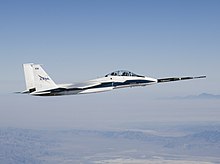
NASA's F-15B Research Testbed, aircraft #836 (74-0141), with the Quiet Spike attachment designed to reduce and control a sonic boom.
- F-15 Streak Eagle (72-0119)
- One stripped and unpainted F-15A, demonstrated the fighter's acceleration – broke eight time-to-climb world records between 16 January and 1 February 1975. It was delivered to the National Museum of the United States Air Force in December 1980.[2]
- F-15 S/MTD (71-0290)
- The first F-15B was converted into a short takeoff and landing, maneuver technology demonstrator aircraft.[72] In the late 1980s it received canard flight surfaces in addition to its usual horizontal tail, along with square thrust-vectoring nozzles. It was used as a short-takeoff/maneuver-technology (SMTD) demonstrator.[73]
- F-15 ACTIVE (71-0290)
- The F-15 S/MTD was later converted into an advanced flight control technology research aircraft with thrust vectoring nozzles.[72]
- F-15 IFCS (71-0290)
- The F-15 ACTIVE was then converted into an intelligent flight control systems research aircraft. F-15B 71-0290 was the oldest F-15 still flying when retired in January 2009.[73]
- F-15 MANX
- Concept name for a tailless variant of the F-15 ACTIVE, but the NASA ACTIVE experimental aircraft was never modified to be tailless.
- F-15 Flight Research Facility (71-0281 and 71-0287)
- Two F-15A aircraft were acquired in 1976 for use by NASA's Dryden Flight Research Center for numerous experiments such as: Highly Integrated Digital Electronic Control (HiDEC), Adaptive Engine Control System (ADECS), Self-Repairing and Self-Diagnostic Flight Control System (SRFCS) and Propulsion Controlled Aircraft System (PCA).[74] 71-0281, the second flight-test F-15A, was returned to the Air Force and became a static display at Langley AFB in 1983.
- F-15B Research Testbed (74-0141)
- Acquired in 1993, it was an F-15B modified and used by NASA's Dryden Flight Research Center for flight tests.[75]
Operators
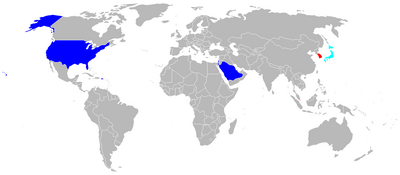
Current operators of the F-15 in light blue, F-15E in red, both in dark blue
For operators of F-15E, F-15I, F-15S, F-15K, F-15SG, and other F-15E-based variants, see McDonnell Douglas F-15E Strike Eagle.
- Israeli Air Force has operated F-15s since 1977, received under Peace Fox I, II and III. These aircraft are currently organized into two F-15A/B squadrons and one F-15C/D squadron. The first 25 F-15A/Bs were early USAF production airframes.[37] The second batch was temporarily embargoed as a result of the 1982 Lebanon War.[76] The IAF had 42 F-15A/C, 15 F-15B/D, and 25 F-15I aircraft in service as of November 2008.[77]
- 106 Squadron ("The Head of the Spear Squadron") Tel Nof Airbase
- 133 Squadron ("The Twin-Tail Knights Squadron") Tel Nof Airbase
Main article: Mitsubishi F-15J
- Japan Air Self-Defense Force acquired 203 F-15Js and 20 F-15DJs from 1981, of which 2 F-15Js and 12 F-15DJs were made in U.S. and the rest by Mitsubishi under license. Japan had 157 F-15Js and 45 F-15DJs in use as of November 2008.[77]
- Royal Saudi Air Force has operated 4 squadrons of F-15C/D (55/19) since 1981, received under Peace Sun. They are based at Dhahran, Khamis Mushayt and Taif air bases. A stipulation in the Camp David Peace Agreement limited the number of Saudi F-15 to 60, holding surplus air frames in Luke AFB for RSAF pilot training. This limitation was later abandoned. The RSAF had 139 F-15C/S and 22 F-15D Eagles in operation as of November 2008.[77]
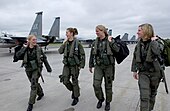
Female pilots walking to their F-15 Eagles at Elmendorf Air Force Base, Alaska
- United States Air Force operated 367 F-15C/D aircraft (233 in active duty and 134 in ANG) as of September 2009.[78] Bold are active units still flying F-15s.
Notable accidents and incidents
Main article: List of F-15 losses
- On 1 May 1983, during an Israeli Air Force training dogfight, an F-15D collided with an A-4 Skyhawk. Unknown to pilot Zivi Nedivi and his copilot, the right wing of the Eagle was sheared off roughly two feet (60 cm) from the fuselage. The F-15 entered a spin after the collision. Zivi decided to attempt recovery and engaged afterburner to increase speed, allowing him to regain control of the aircraft. The pilot was able to prevent stalling and maintain control because of the lift generated by the large horizontal surface area of the fuselage, the stabilators, and remaining wing areas. The F-15 landed at twice the normal speed to maintain the necessary lift, and its tailhook was torn off during the landing. Zivi managed to bring his F-15 to a complete stop approximately 20 ft (6 m) from the end of the runway. He was later quoted as saying "(I) probably would have ejected if I knew what had happened." The fuel leak and vapors along the wing had prevented him from seeing what had happened to the wing itself.[81][82]
- On 19 March 1990, an F-15 from the 3rd Wing stationed at Elmendorf AFB, AK accidentally fired an AIM-9M Sidewinder missile at another F-15. The damaged aircraft was able to make an emergency landing; it was subsequently repaired and returned to service.[83]
- On 22 November 1995, during air-intercept training over the Sea of Japan, a Japanese F-15J flown by Lt. Tatsumi Higuchi was shot down by a AIM-9L Sidewinder missile accidentally fired by his wingman in an incident similar to the one that occurred on 19 March 1990. The pilot ejected safely. Both F-15Js involved were from JASDF 303rd Squadron, Komatsu AFB.[84]
- On 26 March 2001, two US Air Force F-15Cs crashed near the summit of Ben Macdui in the Cairngorms during a low flying training exercise over the Scottish Highlands.[85] Both Lieutenant Colonel Kenneth John Hyvonen and Captain Kirk Jones died in the accident, which resulted in a court martial for an RAF air traffic controller, who was later found not guilty.[86][87]
- On 2 November 2007, a 27-year-old F-15C (s/n 80-0034 of the 131st Fighter Wing) crashed during air combat maneuvering training near St. Louis, Missouri. The pilot, Maj. Stephen W. Stilwell, ejected but suffered serious injuries. The crash was the result of an in-flight breakup due to structural failure. On 3 November 2007, all non-mission critical models of the F-15 were grounded pending the outcome of the crash investigation,[88] and on the following day, grounded non-mission critical F-15s engaged in combat missions in the Middle East.[89] By 13 November 2007, over 1,100 were grounded worldwide after Israel, Japan and Saudi Arabia grounded their aircraft as well.[90] F-15Es were cleared on 15 November 2007 pending aircraft passing inspections.[91] On 8 January 2008, the USAF cleared 60 percent of the F-15A-D fleet for return to flight.[60] On 10 January 2008, the accident review board released its report stating the 2 November crash was related to the longeron not meeting drawing specifications.[61] The Air Force cleared all its grounded F-15A-D fighters for flight on 15 February 2008 pending inspections, reviews and any needed repairs.[63] In March 2008, Stilwell, the injured pilot, filed a lawsuit against Boeing, the F-15's manufacturer.[92]
- On 20 February 2008, two F-15s from 58th Fighter Squadron, 33rd Fighter Wing, flown by Lt. Ali Jivanjee and Capt. Tucker Hamilton collided over the Gulf of Mexico during a training mission. Both pilots ejected and were rescued, but one died later from his injuries.[93] The accident investigation report released 25 August 2008 found that the accident was the result of pilot error and not mechanical failure. Both pilots failed to clear their flight paths and anticipate their impending high-aspect, midair impact according to Brig. Gen. Joseph Reynes Jr., the leader of the investigation team.[94]
Specifications (F-15C Eagle)

Front view of an F-15C with the conformal FAST PACK fuel tanks on the trailers
Data from USAF fact sheet,[95] Jane's All the World's Aircraft,[96] Combat Legend, F-15 Eagle and Strike Eagle[97]
General characteristics- Crew: 1: pilot
- Length: 63 ft 9 in (19.43 m)
- Wingspan: 42 ft 10 in (13.05 m)
- Height: 18 ft 6 in (5.63 m)
- Wing area: 608 ft² (56.5 m²)
- Airfoil: NACA 64A006.6 root, NACA 64A203 tip
- Empty weight: 28,000 lb (12,700 kg)
- Loaded weight: 44,500 lb (20,200 kg)
- Max takeoff weight: 68,000 lb (30,845 kg)
- Powerplant: 2× Pratt & Whitney F100-100 or -220 afterburning turbofans
- Dry thrust: 17,450 lbf (77.62 kN) each
- Thrust with afterburner: 25,000 lbf for -220 (111.2 kN for -220) each
- Fuel capacity: 13,455 lb (6,100 kg) internal[98]
- Maximum speed:
- High altitude: Mach 2.5+ (1,650+ mph, 2,660+ km/h)
- Low altitude: Mach 1.2 (900 mph, 1,450 km/h)
- Combat radius: 1,061 nmi (1,222 mi, 1,967 km) for interdiction mission
- Ferry range: 3,450 mi (3,000 nmi, 5,550 km) with conformal fuel tanks and three external fuel tanks
- Service ceiling: 65,000 ft (20,000 m)
- Rate of climb: >50,000 ft/min (254 m/s)
- Wing loading: 73.1 lb/ft² (358 kg/m²)
- Thrust/weight: 1.12 (-220)
- Guns: 1× 20 mm (0.787 in) M61 Vulcan 6-barreled gatling cannon, 940 rounds
- Hardpoints: Total 11 (not including CFTs): two under-wing (each with additional two missile launch rails), four under-fuselage (for semi-recessed carriage of AIM-7 Sparrows) and a single centerline pylon station, optional fuselage pylons (which may include conformal fuel tanks, known initially as Fuel And Sensor Tactical (FAST) pack for use on the C model) with a capacity of 16,000 lb (7,300 kg) and provisions to carry combinations of:
- Missiles:
- Other:
- up to 3× 600 US gallons (2,300 L) external drop tanks for ferry flight or extended range/loitering time.
- MXU-648 Cargo/Travel Pod - to carry personal belongings, and small pieces of maintenance equipment.[70]
- Missiles:
- Radar:
- Raytheon AN/APG-63 or AN/APG-70[99] (Note: Although several F-15C aircraft were produced with APG-70 radar, all have been retrofitted to the AN/APG-63(V)1 configuration.) or
- Raytheon AN/APG-63(V)1 or
- Raytheon AN/APG-63(V)2 Active Electronically Scanned Array (AESA) or
- Raytheon AN/APG-63(V)3 Active Electronically Scanned Array (AESA) (Note: Both active AF and ANG F-15Cs will receive another (up to) 48 V3 units between 2009-2015, over the existing 19 aircraft.)[100]
- Joint Helmet Mounted Cueing System[100]
- Countermeasures:
- Northrop Grumman Electronic Systems AN/ALQ-131 electronic countermeasures pod[101]
- Hazeltine AN/APX-76 or Raytheon AN/APX-119 Identify Friend/Foe (IFF) interrogator[102]
- Magnavox AN/ALQ-128 Electronic Warfare Warning Set (EWWS) - part of Tactical Electronic Warfare Systems (TEWS)[101]
- Loral AN/ALR-56 Radar warning receivers (RWR) - part of TEWS[103]
- Northrop Grumman Electronic Systems ALQ-135 Internal Countermeasures System (ICS) - part of TEWS[101]
- Marconi AN/ALE-45 Chaff/Flares dispenser system - part of TEWS[104]
Notable appearances in media
Main article: F-15 Eagle in fiction
The F-15 was the subject of the IMAX movie Fighter Pilot: Operation Red Flag, about the RED FLAG exercises. In Tom Clancy's nonfiction book, Fighter Wing (1995), a detailed analysis of the Air Force's premier fighter aircraft, the F-15 Eagle and its capabilities are showcased.[105] Clancy's Red Storm Rising depicts the F-15 as an anti-satellite missile launcher, though incorrectly describes the breakaway altitude as over 94,000 ft (29,000 m), well above the F-15's service ceiling.The F-15 has also been popular subject as a toy, and a fictional likeness of an aircraft similar to the F-15 has been used in cartoons, books and both animated television series and animated films.
 Unknown
Unknown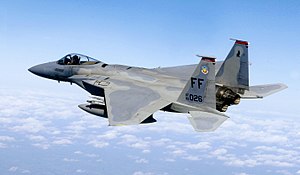





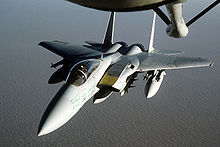


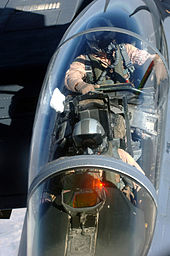












0 komentar:
Post a Comment